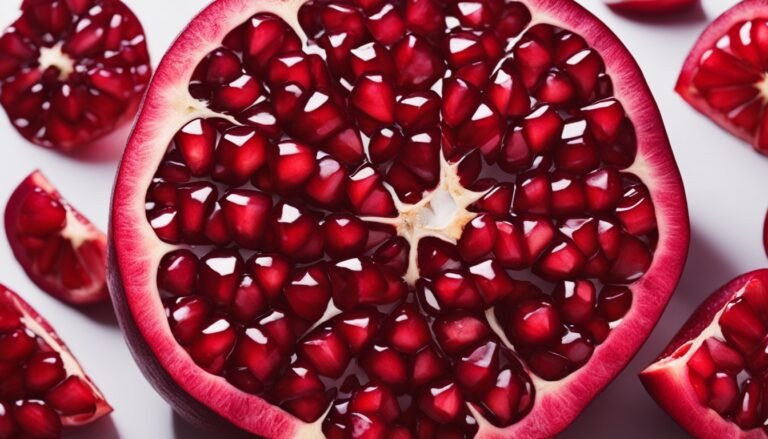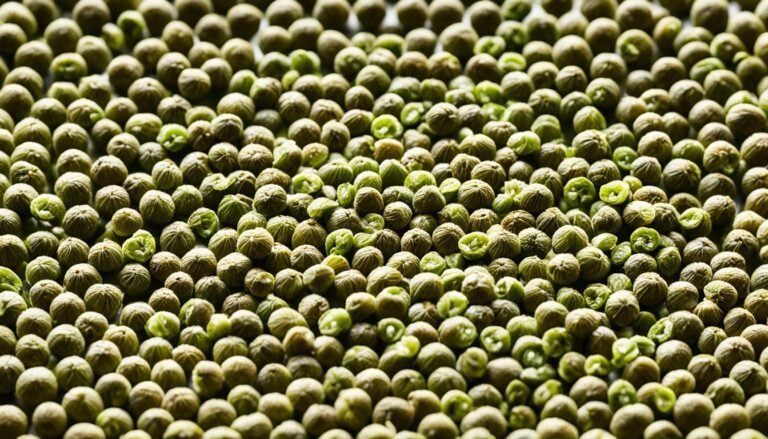Ancient Civilizations: Use of Amaranth Seeds

Amaranth, a superfood, was key for many ancient cultures in South and Central America 6,000-8,000 years ago. It was a main food source. The Aztecs valued its bright leaves and tiny seeds for both everyday use and rituals.
Archaeologists have found evidence of amaranth dating back thousands of years. This shows its long history in the area. The Aztecs, Incas, and Maya saw amaranth as crucial to their diet and culture.
What is Amaranth?
A Nutritious and Resilient Grain
Amaranth is not a cereal grain but a pseudocereal. It’s often called a grain because it’s similar in nutrition. The name “amaranth” means “the never-fading” or “one that does not wither.” This plant is tough and can grow with little water, in droughts, and under strong sunlight.
Amaranth seeds come in colors from cream to dark black, and its leaves can be red to green with purple veins. It’s one of six pseudocereals that are considered whole grains. Unlike other grains, it’s not part of the cereal family. It’s packed with nutrition, having almost twice as much protein as rice and corn.
- Amaranth is a good source of protein, fiber, iron, selenium, vitamin B6, magnesium, phosphorus, and manganese.
- A single serving of cooked amaranth (¼ cup, uncooked) provides 180 calories, 3 grams of fiber, and 7 grams of protein.
- Intact amaranth grains can be stored in the pantry for up to 4 months and in the freezer for 8 months, while whole amaranth flour can be kept in the pantry for 2 months and in the freezer for up to 4 months.
- The recommended cooking method is to combine one cup of dried grain with 2 cups of liquid, bring to a boil, then simmer for 15 to 20 minutes, yielding 2.5 cups of cooked grain.

Amaranth is loved for its nutrition, toughness, and many uses. It’s becoming a top choice in health foods for its benefits.
The Origins and Domestication of Amaranth
Amaranth has a long history that goes back thousands of years. It first started being grown in the Americas. Archaeologists believe it was domesticated between 6,000 to 8,000 years ago.
The wild ancestors of today’s amaranth were the first to be farmed. These early Mesoamerican and Andean people picked out the best plants. They chose ones with bigger seeds and smaller leaves. This made the grains easier to harvest and use.
Archaeologists have found strong proof of this process. They’ve found amaranth seeds in many places across the Americas. For example, they found seeds in Peñas de la Cruz in Argentina that were 7,910 to 7,220 years old. They also found samples in Coxcatlan Cave in Mexico from around 4,000 BCE.
The process of domesticating amaranth was key to ancient farming. It was a staple in the diets of many cultures. The Aztecs, for instance, used it in their religious rituals and food.
| Key Milestones in Amaranth Domestication | Location | Timeframe |
|---|---|---|
| First evidence of domesticated amaranth | South America | 7200-7900 BP |
| Domesticated amaranth found | Tehuacan Valley, Mexico | 6000 YBP |
| Amaranth as part of ancient domesticate complexes | Southwest to Midwest, Ohio Valley | Spanning centuries |
The domestication of amaranth was a key event in its history. It set the stage for its use and importance in the pre-Columbian Americas.

The history of Amaranth seeds in ancient civilizations
Amaranth was key for many ancient Mesoamerican cultures, like the Aztecs and Mixtecs of Oaxaca. The Aztecs grew a lot of amaranth and even used it as a form of tribute. They made flour from it to create images of their god Huitzilopochtli, which were then shared with the people.
The Mixtecs also valued amaranth highly, using it in the turquoise mosaic of a skull found at Monte Albán. Amaranth has been grown since 6700 BCE in the Americas, making it an ancient food crop. Grain amaranths are vital food crops in tropical and subtropical regions of Asia and South America.
- Amaranth seeds yield a wide range of harvest yields, with reported figures ranging from 50 to 7200 kg/ha.
- Highest reported yields of 4600–7200 kg/ha are in South and Middle America, while in Africa, yields vary from 50 to 2500 kg/ha.
- European harvest yields are moderate, ranging from 1200 to 6700 kg/ha, with the most significant production in Russia, totaling around 100,000 ha.
Amaranth can thrive in high temperatures, drought, poor soil, and without major diseases. This makes it perfect for tough growing conditions, especially with climate change. The protein content in amaranth grains is about 15%, with a balanced amino acid mix and high lysine content. This makes it a complete protein source when eaten with another cereal.

The Inca and Aztec civilizations in Mesoamerica used amaranth seeds a lot in their food and religious rituals. Amaranth grains were crucial for the Aztecs and Incas before the arrival of Columbus, along with beans and corn.
The Decline and Rediscovery of Amaranth
The Spanish Conquest and Suppression
During the colonial era, amaranth cultivation fell and almost vanished under Spanish rule. The Spanish aimed to destroy the crop because of its religious importance and use in Aztec rituals. They saw it as a threat to their power. Amaranth fields were destroyed, and those growing it faced harsh punishment.
Even with the Spanish trying hard to eliminate it, amaranth survived in hidden spots. Its ability to adapt and survive helped it to last, despite the efforts to erase it. It wasn’t until the 1970s that amaranth was found and brought back to the U.S. This was thanks to researchers and fans who saw its worth as a superfood and ancient staple crop.
The Spanish conquest and suppression of amaranth during the colonial era greatly hurt its use and growth. Yet, this nutritious and versatile grain managed to survive. This led to its rediscovery and revival in recent times.
The Modern Revival of Amaranth
In recent years, amaranth has seen a big comeback. It’s now grown and used all over the world, not just in the Americas. Countries like China, India, Southeast Asia, West Africa, and the Caribbean now cultivate this ancient grain. Its health benefits and gluten-free nature have made it popular among those looking for nutritious food.
People all over the world are adding amaranth to their traditional dishes. In Ethiopia, it makes a special bread called kita. In India, it’s used in a dessert called laddoos. And in Mexico, the Aztec candies called alegrias feature its unique taste.
The 1970s saw nutritionists rediscover amaranth’s value as a protein and fiber-rich food. Before then, it was overlooked as a food choice. But its nutritional profile soon made it a favorite again.
Now, amaranth greens are harvested in Africa and Asia, and its grains are grown in places like Oaxaca, Mexico. A charity called Puente a la Salud Comunitaria has helped over 6,000 families in more than 80 communities use amaranth and other healthy foods. Farmers in these areas make more money growing amaranth, earning three to five times more than other grains.
Amaranth’s versatility has led to new recipes and dishes. Puente has teamed up with famous chefs to create exciting amaranth-based dishes. They also sell popped amaranth seed to Toronto’s ChocoSol Traders, which brings in almost four times the price.
The comeback of amaranth shows its lasting value and global importance. It’s a sustainable crop that can help fight food shortages and malnutrition. As we face challenges like climate change and the need for nutritious food, amaranth offers hope for a better future.
| Key Statistic | Value |
|---|---|
| Families Reached by Puente a la Salud Comunitaria | 6,000 |
| Communities Reached by Puente a la Salud Comunitaria | Over 80 |
| Profit Increase for Local Farmers Growing Amaranth | 3-5 times higher |
| Price Increase for Popped Amaranth Seed | Almost 4 times higher |
Conclusion
Amaranth has a long history, from being a key food for ancient Mesoamericans to almost disappearing and then being found again. This plant was vital to the diets and cultures of pre-Columbian people. Now, it’s making a comeback, showing how important ancient grains are for today’s food and farming challenges.
Exploring amaranth’s potential shows how valuable our old foods still are. It’s a complete protein, resistant to Roundup, and grows in many places. This makes it a key player in ensuring food security and sustainable farming. Groups like Qachuu Aloom are working hard to keep amaranth alive and sharing its seeds with others.
Bringing back amaranth and other ancient grains does more than feed us. It honors the traditions of the past. By learning from these crops, we can create a food system that’s strong, fair, and meets our changing needs. Amaranth’s story teaches us about the strength of our agricultural heritage and how it can guide us to a better future.
FAQ
What is the history of amaranth seeds in ancient civilizations?
Amaranth was a key food for many ancient cultures in South and Central America. The Aztecs were among them. Archaeologists found evidence of amaranth seeds from 6,000-8,000 years ago. It was a major crop and even a form of tribute for the Aztecs.
What are the unique characteristics of amaranth?
Amaranth isn’t a true cereal grain but a pseudocereal. Its seeds are pale cream with some black ones mixed in. The leaves vary from deep red to light green with purple veins. It’s easy to grow with little water and thrives in sunny areas.
When and where was amaranth first domesticated?
Amaranth was domesticated 6,000-8,000 years ago in the Americas. The wild ancestor Amaranthus hybridus was its starting point. Archaeologists found evidence in places like Peñas de la Cruz in Argentina and Coxcatlan Cave in Mexico.
How was amaranth used by ancient civilizations in Mesoamerica?
In Mesoamerica, amaranth was vital for many cultures, like the Aztecs and Mixtecs. The Aztecs grew a lot of it and used it as tribute. They also made images of their god Huitzilopochtli from its flour.
What happened to amaranth during the Colonial era?
During the Colonial era, amaranth cultivation almost stopped under Spanish rule. The Spanish banned it for its religious ties and use in Aztec rituals. They punished those who grew it. Yet, some amaranth survived in hidden areas.
How has amaranth made a comeback in modern times?
The 1970s saw amaranth’s return to the U.S., thanks to researchers and fans. Now, it’s grown worldwide, including in China, India, and Africa. Its health benefits and versatility have made it popular again.






